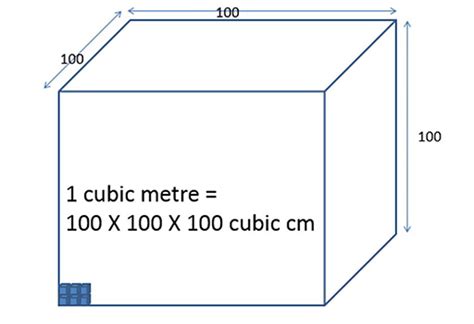How Many Cubic Meters Are In A Cubic Centimeter
News Co
Apr 04, 2025 · 4 min read

Table of Contents
How Many Cubic Meters Are in a Cubic Centimeter? Understanding Metric Conversions
Understanding unit conversions is crucial in various fields, from engineering and physics to everyday life. One common conversion involves cubic measurements, specifically relating cubic centimeters (cm³) and cubic meters (m³). This article will delve deep into this conversion, explaining the process, providing practical examples, and highlighting its significance in different applications.
Understanding Cubic Measurements
Before diving into the conversion, let's clarify what cubic measurements represent. A cubic measurement defines the volume of a three-dimensional space. A cubic centimeter (cm³) is the volume of a cube with sides measuring one centimeter each. Similarly, a cubic meter (m³) is the volume of a cube with sides measuring one meter each. The key difference lies in the scale: a meter is significantly larger than a centimeter.
The Conversion Factor: The Heart of the Matter
The core of converting cubic centimeters to cubic meters lies in understanding the relationship between centimeters and meters within the metric system. One meter is equal to 100 centimeters (1 m = 100 cm). This seemingly simple fact is the foundation upon which the cubic conversion is built.
Since we're dealing with cubic units, we need to consider the three-dimensional aspect. When converting from centimeters to meters, we're not just dealing with a linear relationship; we're dealing with volume. Therefore, we need to cube the conversion factor.
This means: (1 m / 100 cm)³ = 1 m³ / 1,000,000 cm³
This equation tells us that one cubic meter contains 1,000,000 cubic centimeters. This is the crucial conversion factor we'll use throughout our calculations.
The Conversion Formula: A Step-by-Step Guide
To convert cubic centimeters (cm³) to cubic meters (m³), you'll use the following formula:
Cubic Meters (m³) = Cubic Centimeters (cm³) / 1,000,000
This formula divides the number of cubic centimeters by one million to obtain the equivalent volume in cubic meters. Let's illustrate this with some examples.
Example 1: A Small Volume
Let's say you have a container with a volume of 500,000 cm³. To convert this to cubic meters:
Cubic Meters (m³) = 500,000 cm³ / 1,000,000 = 0.5 m³
Therefore, 500,000 cubic centimeters is equal to 0.5 cubic meters.
Example 2: A Larger Volume
Now, let's consider a larger volume, say 2,500,000 cm³. Applying the formula:
Cubic Meters (m³) = 2,500,000 cm³ / 1,000,000 = 2.5 m³
This shows that 2,500,000 cubic centimeters is equivalent to 2.5 cubic meters.
Example 3: A Very Small Volume
Even for extremely small volumes, the formula remains the same. Let's say you have a volume of 100 cm³.
Cubic Meters (m³) = 100 cm³ / 1,000,000 = 0.0001 m³
This illustrates that even tiny volumes can be expressed in cubic meters, albeit with a very small value.
Practical Applications: Where This Conversion Matters
The conversion between cubic centimeters and cubic meters is essential in numerous practical situations:
-
Engineering and Construction: Calculating the volume of materials like concrete, soil, or water for construction projects requires accurate conversions between these units. Accurate volume calculations are crucial for material estimations and cost calculations.
-
Fluid Dynamics: In fluid mechanics, understanding the volume of fluids in various units is crucial for analyzing flow rates, pressures, and other fluid properties. This is important for designing efficient pipelines, water systems, and other fluid-related infrastructure.
-
Medical Applications: In medicine, accurate measurements of volumes are essential for various procedures and treatments, from administering medications to performing surgeries. The ability to convert between cubic centimeters and cubic meters ensures precision in these critical applications.
-
Chemistry and Physics: In chemistry and physics, accurate volume measurements are fundamental for conducting experiments and calculations involving solutions and gases. The conversion between these units ensures consistency and accuracy in scientific research and industrial processes.
-
Environmental Science: Environmental scientists use volume calculations to analyze pollutant concentrations, measure water flow in rivers, and assess the impact of environmental changes. Accurate conversions between cubic centimeters and cubic meters are essential for obtaining reliable environmental data.
Beyond the Basics: Exploring Related Conversions
While the focus here is on converting cubic centimeters to cubic meters, it's helpful to understand related conversions. For instance, you can also convert liters to cubic meters. One liter is equal to 1000 cubic centimeters (1 L = 1000 cm³). Therefore, you can use this relationship alongside the cm³ to m³ conversion to easily convert liters to cubic meters.
Similarly, you can explore conversions involving other cubic units like cubic millimeters (mm³) or cubic kilometers (km³). The principles remain the same: you'll need to determine the linear relationship between the units and then cube that relationship to find the cubic conversion factor.
Conclusion: Mastering Metric Conversions for Accurate Results
Mastering the conversion between cubic centimeters and cubic meters is a valuable skill with far-reaching implications. The formula, cm³/1,000,000 = m³, provides a straightforward method for accurate conversion, crucial in various scientific, engineering, and everyday contexts. Understanding the underlying principles and practicing with different examples will solidify your grasp of this fundamental conversion, contributing to more precise calculations and a deeper understanding of metric units. Remember to always double-check your calculations to ensure accuracy and reliability in your results. The ability to perform these conversions proficiently is a key component of success in many fields.
Latest Posts
Related Post
Thank you for visiting our website which covers about How Many Cubic Meters Are In A Cubic Centimeter . We hope the information provided has been useful to you. Feel free to contact us if you have any questions or need further assistance. See you next time and don't miss to bookmark.